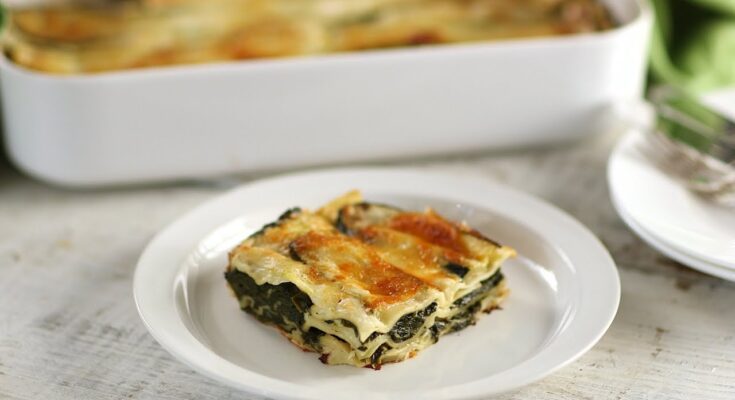Spinach Lasagna Recipe: Spinach lasagna is like the cozy, veggie-packed cousin of traditional meat lasagna. It’s hearty, flavorful, and checks all the boxes for comfort food—with a healthy twist. Instead of heavy meat sauces, we’re working with a bright, creamy spinach filling that not only delivers in flavor but also adds a nutritious punch. Whether you’re a full-on vegetarian or just looking to cut back on meat, this dish is a total crowd-pleaser. Imagine tender layers of pasta, rich cheeses, and savory spinach all baked together into one warm, melty masterpiece.
What sets spinach lasagna apart is its balance. It’s rich without being heavy, indulgent yet still gives you that “I ate something good for me” feeling. Plus, it’s super adaptable. Want to add mushrooms? Go for it. Prefer a different cheese blend? Be my guest. And let’s not forget—it’s just plain delicious.
Ingredients You’ll Need
Before we dive into the step-by-step magic, let’s round up everything you’ll need for this spinach lasagna. Good prep makes the process smoother and the results tastier.
For the Spinach Filling:
- 2 tablespoons olive oil
- 3 cloves garlic, minced
- 1 onion, finely chopped
- 16 oz fresh spinach (or 10 oz frozen spinach, thawed and drained)
- Salt and pepper to taste
For the Cheese Mixture:
- 15 oz ricotta cheese
- 1 large egg
- ½ cup grated parmesan cheese
- 1 teaspoon dried basil or Italian seasoning
- Salt and pepper
For the Lasagna:
- 9-12 lasagna noodles (regular or oven-ready)
- 2 cups shredded mozzarella cheese
- 2 cups marinara sauce (store-bought or homemade)
Optional: Red pepper flakes, fresh parsley, or extra cheese for topping
Everything here is easy to find and budget-friendly. You can even swap things around—like using cottage cheese instead of ricotta, or fresh herbs instead of dried. Make it yours!
Step-by-Step Instructions to Make Spinach Lasagna
Step 1: Prepare the Spinach Filling
Start with the star of the show—spinach. If you’re using fresh spinach, heat the olive oil in a large skillet over medium heat. Add the chopped onion and cook until translucent, about 4-5 minutes. Toss in the minced garlic and let it sizzle for about 30 seconds.
Now, pile in the spinach. It’ll look like a lot, but don’t worry—it wilts down fast. Sauté until it’s completely wilted and any moisture has evaporated. Season with a pinch of salt and pepper. If you’re using frozen spinach, make sure to thaw and press out as much liquid as possible before adding it to the pan.
This step is crucial. Too much moisture in your spinach will turn your lasagna into a watery mess. Drain and set the filling aside to cool a bit before layering.
Step 2: Make the Cheese Mixture
In a mixing bowl, combine ricotta cheese, grated parmesan, an egg, and dried basil. Add salt and pepper to taste. The egg helps bind everything together, giving you that creamy, cohesive texture once it bakes.
Want to up the flavor? Stir in a touch of garlic powder or even some finely chopped fresh basil if you have it on hand. This mix is going to be one of your lasagna’s key flavor bombs, so don’t be shy with the seasoning.
Step 3: Cook the Lasagna Noodles
Bring a big pot of salted water to a boil and cook your lasagna noodles according to the package directions. Aim for al dente—you want them firm enough to hold up during baking. Drain them and lay them out flat on a baking sheet, separating with parchment paper or a little oil to prevent sticking.
If you’re using oven-ready noodles, you can skip this step. Just make sure your sauce has enough moisture to cook them properly in the oven.
Step 4: Layer the Lasagna
Now comes the fun part—layering your lasagna. Preheat your oven to 375°F (190°C). Grab a 9×13 inch baking dish and let’s start stacking.
Begin with a thin layer of marinara sauce on the bottom. This prevents sticking and keeps the first noodle layer nice and moist. Next, lay down 3 to 4 noodles side-by-side, slightly overlapping if needed. On top of the noodles, spread a generous layer of the ricotta cheese mixture, followed by a spoonful or two of sautéed spinach, and then a drizzle of marinara sauce. Sprinkle a handful of shredded mozzarella on top.
Repeat this process—noodles, cheese, spinach, sauce, mozzarella—until you run out of ingredients or reach the top of your dish. Ideally, you want 3 full layers. Finish off with a final layer of noodles, the remaining marinara sauce, and a heavy sprinkling of mozzarella and parmesan cheese. This cheesy top will form that golden, bubbly crust everyone loves.
Want to get a little fancy? Add some fresh basil leaves or a dusting of red pepper flakes to the top before baking for an extra punch of flavor and presentation points.
Step 5: Bake the Lasagna
Cover your dish with aluminum foil—tenting it slightly so it doesn’t stick to the cheese—and bake for 25 minutes. Then remove the foil and continue baking for another 15 to 20 minutes, or until the top is golden and bubbling. If you like a slightly crispier top, you can broil it for the last 2-3 minutes, but watch it closely!
Once it’s done, resist the temptation to dive right in. Let the lasagna rest for at least 10-15 minutes before cutting into it. This allows everything to set and makes it much easier to serve perfect slices.
Now your kitchen smells like heaven and you’ve got a bubbling tray of cheesy, veggie-packed goodness ready to impress. Whether it’s for a family dinner, a potluck, or meal prepping for the week, this spinach lasagna hits the spot every single time.
Tips for the Perfect Spinach Lasagna
- Use full-fat ricotta for a creamier texture and richer taste.
- Drain your spinach well, especially if you use frozen—excess water can ruin the texture.
- Don’t overdo the sauce. Too much marinara can make your lasagna soggy.
- Add extra cheese to the top in the last 10 minutes for a golden crust.
- Let it rest. As tempting as it is to dig in right away, giving it 15 minutes to cool will keep your layers intact and firm.
Lasagna is all about layers—of flavor, texture, and comfort. And once you get the technique down, it’s hard to go wrong. This recipe gives you a solid foundation to play with, tweak, and make your own.
Storage and Reheating Instructions
One of the best things about spinach lasagna—besides how amazing it tastes—is how well it stores and reheats. Whether you’re meal prepping for the week or saving leftovers from a dinner party, this dish keeps its flavor and texture like a champ.
To store in the fridge: Once your lasagna has completely cooled, cover the dish tightly with foil or transfer portions into airtight containers. It will stay fresh in the refrigerator for up to 4-5 days. If you’re using foil, make sure it’s wrapped snugly to prevent the lasagna from drying out.
To freeze: Spinach lasagna freezes beautifully, making it ideal for batch cooking. Slice it into individual servings and wrap each tightly in plastic wrap, followed by a layer of aluminum foil. Or store the entire dish if you’re freezing it for a family meal. Place the wrapped lasagna in a freezer-safe bag or container. It’ll last up to 3 months without losing much of its flavor.
Reheating tips: To reheat from the fridge, place a slice in the oven or toaster oven at 350°F for about 15–20 minutes, or until heated through. You can also microwave it in 1-minute intervals, though you might lose a bit of that crispy cheese texture. If reheating from frozen, it’s best to thaw overnight in the fridge, then warm in the oven.
The goal is to keep the lasagna moist without drying it out—so don’t skip covering it with foil while reheating in the oven.
Variations to Try
One of the most lovable aspects of spinach lasagna is how easy it is to customize. Whether you’re vegan, gluten-free, or just in the mood to experiment, here are some tasty variations you can try:
1. Vegan Spinach Lasagna
Skip the eggs and dairy, and use:
- Vegan ricotta made from tofu or cashews
- Plant-based mozzarella
- Nutritional yeast for that cheesy flavor
- Vegan marinara or tomato sauce
It still comes out creamy, savory, and completely satisfying.
2. Add Mushrooms or Tofu
Want more texture and protein? Sauté mushrooms or crumbled tofu with garlic and onions and mix them into the spinach layer. Mushrooms add an earthy depth, while tofu soaks up all the flavors like a sponge.
3. Try Different Cheeses
Mix it up with cheeses like:
- Fontina for a buttery melt
- Gouda for smokiness
- Feta for a tangy kick
Combining cheeses gives your lasagna a gourmet touch and adds layers of complexity to the flavor.
4. Gluten-Free Version
Use gluten-free lasagna noodles, available at most grocery stores now. Be sure to slightly undercook them so they don’t go mushy in the bake.
These variations are perfect for adapting the recipe to different dietary needs or simply changing things up for fun. Every version is still comforting, hearty, and delicious in its own right.
Nutritional Benefits of Spinach Lasagna
Let’s talk about why spinach lasagna isn’t just delicious—but good for you too. Yes, it’s cheesy and carb-loaded, but it also sneaks in a ton of nutrients, especially from the spinach.
Here’s what you’re getting:
- Iron & Folate: Spinach is a powerhouse of iron and folate, essential for red blood cell production and heart health.
- Calcium & Protein: Ricotta, parmesan, and mozzarella aren’t just tasty—they’re packed with calcium and protein, key for bone strength and muscle repair.
- Fiber: The spinach and tomato sauce add a good amount of dietary fiber, which helps digestion and keeps you full longer.
If you’re watching your calories, you can tweak the ingredients to make it lighter—use part-skim cheeses, less oil, or increase the spinach-to-cheese ratio. Even in its classic form, spinach lasagna is one of those rare comfort foods that gives back more than just flavor.
FAQs about Spinach Lasagna Recipe
1. What ingredients are needed for spinach lasagna?
To make spinach lasagna, you will need lasagna noodles, fresh spinach, ricotta cheese, mozzarella cheese, Parmesan cheese, eggs, garlic, onion, marinara sauce, olive oil, salt, and pepper.
2. Can I use frozen spinach instead of fresh?
Yes, frozen spinach can be used in place of fresh spinach. Make sure to thaw and thoroughly drain the frozen spinach to remove excess moisture before adding it to your lasagna.
3. How long does it take to cook spinach lasagna?
Spinach lasagna typically takes about 45 minutes to bake in a preheated oven at 375 degrees Fahrenheit. Remember to cover with foil for the first 30 minutes and then uncover for the last 15 minutes to allow the cheese to brown.
4. Is spinach lasagna healthy?
Spinach lasagna can be a healthy option as it includes spinach, which is high in iron and vitamins, and cheeses that provide calcium. To make it healthier, consider using low-fat cheeses and increasing the amount of spinach.
5. Can spinach lasagna be made ahead of time?
Yes, you can prepare spinach lasagna ahead of time. Assemble the lasagna as directed, cover it tightly with foil, and refrigerate. When ready to bake, you may need to add an extra 10-15 minutes to the cooking time if baking from cold.
6. How can I prevent my lasagna from being watery?
To prevent a watery lasagna, ensure that your spinach is well drained of any excess water, and consider using a thicker marinara sauce. Letting the lasagna set for 10-15 minutes after baking before cutting can also help it hold together better.
7. What can I serve with spinach lasagna?
Spinach lasagna pairs well with a light salad, garlic bread, or steamed vegetables. These sides complement the rich flavors of the lasagna without overpowering it.
Final Thoughts
Spinach lasagna is more than just a dinner dish—it’s a celebration of comfort, flavor, and simple ingredients coming together in harmony. With layers of melty cheese, tender noodles, and garlicky spinach, this meal is a guaranteed hit for both weeknights and special occasions.
Whether you’re a seasoned home cook or trying this out for the first time, you’ll find that making spinach lasagna from scratch is not only doable, but deeply rewarding. It freezes well, feeds a crowd, and offers tons of ways to tweak it to your liking.
Now that you’ve got the full step-by-step guide, it’s your turn to roll up those sleeves and get cooking. Don’t be afraid to experiment, personalize the recipe, and make it truly your own.



